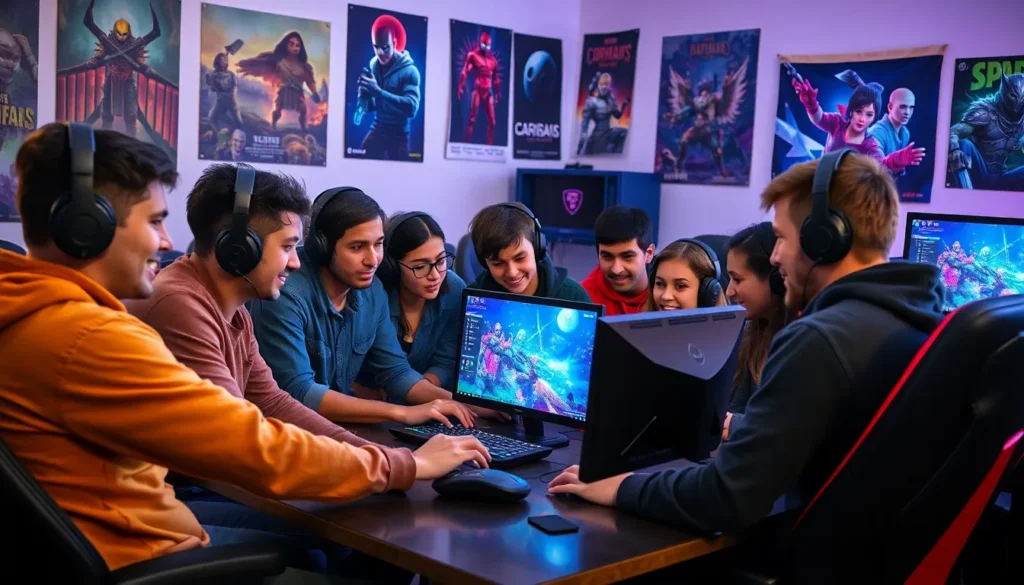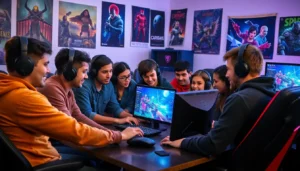Table of Contents
ToggleIn the ever-evolving world of online gaming, server merges can feel like a giant game of musical chairs—except when the music stops, everyone’s still standing, and the chairs are all occupied. As players band together to tackle challenges and build communities, understanding the ins and outs of server merges becomes crucial. It’s not just about combining players; it’s about creating a vibrant ecosystem where friendships flourish and epic battles await.
Overview of Server Merge Info
Server merges play a crucial role in enhancing the online gaming experience. These merges bring together players from different servers, creating larger communities that foster collaboration and competition. Through this process, players adapt to new dynamics, ensuring that the environment remains vibrant and engaging.
Players often notice significant benefits following a server merge. Increased player populations lead to more active gameplay, with comprehensive interactions and cooperation among guilds or clans. Engaging with a larger audience creates opportunities for players to forge new friendships and alliances, enriching the overall social experience.
For developers, server merges can relieve strain on server resources, optimizing game performance. When multiple servers merge, it allows for improved load balancing, reducing downtime and ensuring smoother gameplay sessions. This improvement encourages retention, as players are more likely to remain engaged within a stable network.
Additionally, the integration process might include adjustments to in-game economy systems. Players often face challenges with market fluctuations as they navigate a merged environment. Adapting to these changes can enhance strategic gameplay and deepen players’ understanding of game mechanics.
Lastly, communication becomes vital in merged servers. Players need to remain informed about updates, events, and changes brought by the merger. Developers often provide detailed information through announcements, ensuring all players understand the new environment and how to thrive within it.
Through these various aspects, server merges not only serve to unify players but also enhance their overall experience, leading to more dynamic and engaging gameplay.
Benefits of Server Merges

Server merges offer significant advantages for players and developers alike. They lead to enriched gameplay and foster vibrant communities.
Improved Gameplay Experience
Enhanced player populations contribute to a more dynamic and competitive environment. As larger groups engage in game activities, challenges become more exciting and rewarding. Developers can allocate resources more efficiently, ensuring smoother gameplay and fewer disruptions. Features like PvP events and guild battles thrive with increased participation. Players also enjoy broader matchmaking options, helping to reduce wait times and improve satisfaction during competitive modes.
Enhanced Community Interaction
Stronger communities emerge from server merges, encouraging interaction among players. With more participants, players can easily find others who share similar interests and goals. This increased connectivity boosts collaboration in quests and events, fostering friendships that enrich the gaming experience. Communication tools within games often evolve to support larger groups, promoting teamwork. A vibrant community facilitates the exchange of knowledge, strategies, and resources, enhancing overall engagement and satisfaction.
Challenges of Server Merges
Server merges present several challenges that can impact both players and developers.
Technical Issues
Technical issues often arise during server merges despite planning. Data transfer errors may occur, resulting in lost characters or items. Server overload is another common concern, especially when high volumes of players log in simultaneously. Performance lags can disrupt gameplay, frustrating users. Network instability might lead to disconnections, further complicating the experience. Testing procedures must be thorough to mitigate these risks, ensuring smoother transitions.
Player Resistance
Player resistance can significantly affect the success of server merges. Players may feel anxious about losing their established communities. Uncertainty regarding changes in game dynamics can lead to frustration. Players frequently voice concerns over potential imbalances, particularly if perceived favoritism is evident. Balancing incentives for merging servers becomes critical to easing apprehension. Effective communication from developers helps to address worries and foster understanding. Building trust and encouraging participation is essential for creating a cohesive environment post-merge.
Steps to Implement Server Merges
Effective server merges require careful planning and execution to ensure a smooth transition. Developers must prioritize communication with players to keep them informed throughout the process.
Pre-Merge Preparations
Evaluating server health forms the initial step in preparations. Identifying underperforming servers helps determine which ones require merging. Assessing player populations reveals community strengths and weaknesses. Engaging with players provides valuable feedback and addresses concerns. Announcing timeline details and significant changes sets expectations and reduces anxieties. Preparing technical infrastructure ensures adequate resources for the merged servers, avoiding overload and performance issues.
Post-Merge Adjustments
Evaluating player feedback post-merge allows developers to identify areas for improvement. Adjusting in-game economy systems promotes balance as players adapt. Offering incentives to encourage exploration and collaboration fosters engagement among communities. Monitoring server performance ensures stability and responsiveness during peak times. Communicating updates regularly helps manage expectations, addressing any lingering concerns. Lastly, establishing support channels enables players to report issues quickly, enhancing overall satisfaction.
Best Practices for Successful Merges
Planning is essential for successful server merges. Evaluate server health metrics to ensure optimal conditions before merging. Assess player populations to identify which servers will combine effectively. Engaging directly with players soon builds trust and gathers valuable feedback, facilitating smoother transitions.
Communication must remain transparent throughout the process. Announce timelines well in advance, detailing steps players can expect. Address player concerns promptly to foster a sense of security and inclusion. Update the community regularly, sharing developments that affect their gameplay experience.
Technical readiness cannot be ignored during preparation. Ensure robust technical infrastructure capable of handling increased traffic from merged servers. Conduct thorough testing to identify potential data transfer errors or network issues ahead of time, minimizing disruptions during the merge.
Post-merge, it’s crucial to monitor performance actively. Evaluate player feedback thoroughly to identify areas requiring adjustment, especially in-game economy systems. Offer incentives that encourage collaboration among newly formed communities. This support leads to increased participation and helps shape a vibrant environment.
Establishing responsive support channels can significantly enhance player satisfaction. Proactively assist players with any concerns they may have following the merge. Promoting an open dialogue allows for ongoing adjustments and fosters long-term engagement.
Focusing on these best practices ensures that server merges effectively unify players. A strategic approach creates a solid foundation for enhanced gameplay experiences and thriving communities in the merged environment.
Server merges represent a significant evolution in online gaming. They not only enhance player experiences but also foster stronger communities. As players adapt to new dynamics they discover opportunities for collaboration and competition that enrich their gameplay.
Developers play a crucial role in this process by ensuring smooth transitions and maintaining open lines of communication. Addressing player concerns and providing ongoing support can mitigate challenges associated with merging servers.
Ultimately a well-executed server merge can lead to a vibrant gaming environment where players thrive together. This creates lasting friendships and exciting gameplay experiences that keep players engaged and invested in their virtual worlds.







